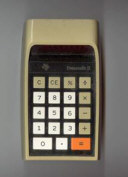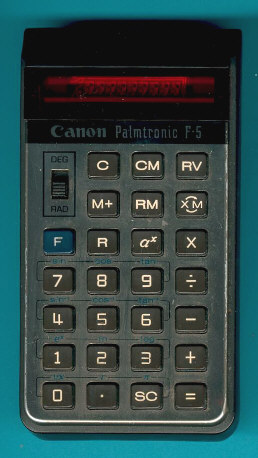
DATAMATH CALCULATOR MUSEUM
 |
DATAMATH CALCULATOR MUSEUM |
Canon F-5
| Date of introduction: | April 1974 | Display technology: | LED-stick |
| New price: | Display size: | 8 | |
| Size: | 5.5" x 3.1" x 1.5" 139 x 78 x 37 mm3 |
||
| Weight: | 6.5 ounces, 184 grams | Serial No: | 517382 |
| Batteries: | 4*NiCd AA or 4*AA Alkaline | Date of manufacture: | year 1974 |
| AC-Adapter: | Origin of manufacture: | Japan | |
| Precision: | 8 | Integrated circuits: | Rockwell A4001-15471 |
| Memories: | 1 | ||
| Program steps: | Courtesy of: | Joerg Woerner |
 The
Palmtronic F-5 is a very unusual calculator manufactured by Canon. It was
introduced mid of the year 1974 like the Texas Instruments SR-16
or the SR-50.
The
Palmtronic F-5 is a very unusual calculator manufactured by Canon. It was
introduced mid of the year 1974 like the Texas Instruments SR-16
or the SR-50.
 The F-5 combined due to
its Rockwell calculator chip the functions of the SR-50 with the inaccuracy of
the SR-16! A similar poor performance could be found in the huge Palmtronic
F-7.
The F-5 combined due to
its Rockwell calculator chip the functions of the SR-50 with the inaccuracy of
the SR-16! A similar poor performance could be found in the huge Palmtronic
F-7.
The same housing was used with the rare FC-80 metric conversion calculator and the more common LE-81M and LE-100 basic calculators introduced in the same time frame. Later products like the LE-83 used a much cheaper construction.
The next calculator in Canon's scientific line was the F-6 with a complete new housing.
The F-5 wasn't the only "TI-less" calculator sold by Canon in the early days, view the odd LE-81. The last calculator with a TI brain was found with the Palmtronic F-31.
Running Mike Sebastian's "Calculator forensics" returns an unacceptable bad result of 10.4382 instead the expected value close to 9.0000. This places the F-5 in the league of boring calculators like the Canon F-6 (12.199423) and the never released SR-40 prototype (10.271817).
Another known side effect of the poor algorithm of the Rockwell calculator chips could be discovered with the unusual [ax] key:
Rockwell uses - like most other companies - the
equation: It is easy to proof:
|
If you have additions to the above article please email: joerg@datamath.org.
© Joerg Woerner, December 5, 2001. No reprints without written permission.